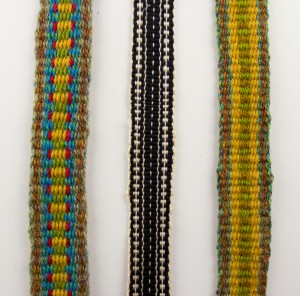Nancy Smeltzer, MFA In the late 60s and early 70s, there was a big move on to return to traditional textile techniques, as many of the people who knew how to do them had died, or their companies had moved overseas. While getting my portfolio together to go to The Maryland Institute of Art for my MFA, I learned crochet, macrame, and many other techniques that had been laid to the side for more modern objects and materials. One of these techniques was inkle weaving. On the left are some pretty simple versions that I made. If you Google inkle weaving, and look at the “images” section, there are many more complicated examples than mine. I got bored rather quickly with the process, since you had to manually make the “shed” or the place where the shuttle with the thread/yarn on it would be passed. To make that shed. the loom that I was using had a flat wooden piece with a notched edge to it, and that allowed a little more ease in picking up the warp or vertical threads that I wanted. You then turned the flat edge on it’s side, and that made enough room to pass the shuttle through with the color for that row.
The loom that I used was a simple table top one, although there are ones that are made that are floor models if you want to make a lot of the same pattern. This table model allowed me to make lengths about 3 feet (9 m). The above samples are about 1″ (2.5cm) wide, but I could have made them wider if I had wanted to do so. I wanted to hurry and learn as many patterns as I could, and in keeping with the times, used rustic materials such as butcher and other forms of twine. Since inkle weavings are often used as guitar straps, belts, and other forms of narrow textiles, the scratchy twine would not have been very comfortable, especially going around your neck. However, this was the time when we were “being real and true to our roots”, not that a country girl from North Carolina would have had any relatives that I knew of that had done such work. It was fun learning about folk traditions, especially through classes at the Smithsonian, such as learning to crochet with your fingers. This apparently was one early way that man learned to make fabric until someone realized that a stick or bone with a notch at the end would make things go a lot faster. My simple inkle loom would have been quite a step up in technology from the primitive finger crocheting. As I was cleaning out my studio to move, it was hard to give up the several looms that I had collected over the years from art teachers who didn’t know how to use them, and weren’t very interested in learning, since you would need one loom/child in each class. My looms ended up going to a friend who is starting a weaving studio, so I know that they’ll have a good home and traditions will be passed on.
What are some textile traditions that you have in your family? My grandmother used to crochet white edges around wash cloths.
Why not leave a comment as to your thoughts on this posting. Please take a minute, fill out the form below or by clicking on the “comments/no comments link” at the top of the posting, and then share your ideas with the rest of us. We all grow when we share our thoughts and impressions, so why not join our growing community of those who appreciate art quilts and textile arts. We’d love to hear from you!… and PLEASE tell like minded souls about this blog! The more readers and contributors, the more I write because encouragement helps the words flow! You can see more of my art work on my web site at www.fiberfantasies.com (be patient as it loads; it’s worth it), my spiritual healing work at www.transitionportals.com and can find me on Google + , Facebook (for Transition Portals) Facebook (for Fiber Fantasies), and Twitter. To find out how to buy my art work, please check out “How to Buy my Art Work” in the “Pages” section to the right of this blog.


